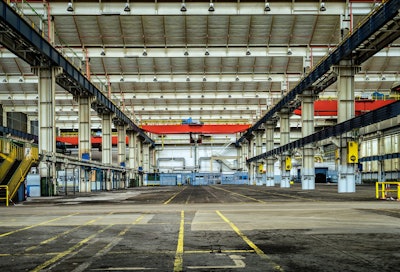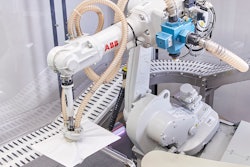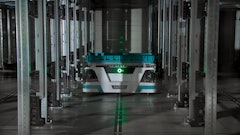
The optimism in the global warehouse robotics market comes from the benefits derived from the implementation of artificial intelligence and machine learning in a warehouse setting. Warehousing has come a long way from those days when it was a labor-intensive trade to this day when man and machines work together in every step of the supply chain.
The warehousing industry is expected to witness significant demand in the deployment of robotic systems as it enables companies to optimize workflows, lessen the cost of labor, and increase the bottom line. The growing awareness about workplace safety, improved production quality, and rising demand for automation are likely to present lucrative opportunities for growth of the global warehouse robotics market. These growth inducing factors are estimated to propel the warehouse robotics market expand at a CAGR of 12% from 2019 to 2027, touch market valuation of $9.5 billion by 2027. End-use industries of the market in the review are anticipated to leverage on the benefits offered by warehouse robotics to improve their return on investment (ROI), make the flow of materials more efficient, and better productivity.
"Increasingly one should be searching for future logistics solutions in robotics, automation, and artificial intelligence (AI) – a significant facet of several robotic solutions Robotics in the manufacturing industry is well established since many years and it is expected that the applications within the periphery of warehouse operations will be increasingly mainstreamed," notes Transparency Market Research.
Key Findings of the Market Study
- Among the end-use industries, major shares of revenues are likely to come from the e-commerce and retail industries.
- Among various applications, picking and packaging is expected to emerge as the most popular. Warehouse robots can lessen the time to walk and shorten the routes of picking, and perform accurate picking and packing tasks.
- Among the product types, automated storage and retrieval system (ASRS) is likely to offer considerable opportunities to the global warehouse robotics market.
Warehouse Robotics Market: Key Driving Factors
According to the findings of the global warehouse robotics market by TMR, the growth of the market is fueled by the clear and tangible benefits that warehouse robotics bring to several businesses. Augmented efficiency and cutting down of expenses are some of the apparent outcomes for most of the companies. However, businesses could also find less obvious ways of benefitting from robotic technology.
Deployment of warehouse robotics results in fewer errors. Human errors could prove to be costly for the business. It also ensures increased safety in the workplace as robots takeover hazardous jobs that could put the life and health of workers at jeopardy. In addition, deployment of robots can boost the image of the brand. Accelerated movement of goods inside the warehouse and across the supply chain ensures the faster accomplishment of tasks and delivery, which could present the company as a better brand.
Small and medium enterprises (SMEs) are in particular serving as a platform for the generation of promising opportunities for the global warehouse robotics market. Increasing demand for industrial robots from the small and medium enterprises sector is a manifestation of their resolution to keep up with the cutting-edge technology and efficiency. It is despite that fact that deployment of warehouse robotic technology is usually a luxury for the often resource-strapped small and medium enterprises.
- Automated Storage and Retrieval Systems (ASRS) solutions are anticipated to be the most popular product type. It automates the process of inventory. It helps in the retrieval of goods for use or shipment and then returning the items back to their storage locations.
- Warehouse robots with the capacity of below 10 kg payload are estimated to account for a considerable share of the revenue. This is ascribed to the fact that these lower payload capacity robots carry most of the items in a facility that caters to several end-use industries.
- The Warehouse Management System (WMS) software is likely to emerge as a popular software to be used by several companies.
Key Impediments for Warehouse Robotics Market Players
According to the study, the key restraints hampering the market growth comprise:
- There is a lack of awareness about warehouse robots, which is posing a serious challenge to its promising growth opportunities.
- High cost of deployment is another factor that is compelling many companies, particularly the smaller ones, to either delay or not deploy at all warehouse robotics.
Market: Region-wise Analysis
- One of the most lucrative regional market with a promise of stellar growth is the North America market. Territorial dominance of North America is due to the impressive proliferation of advanced technologies together with the vital presence of various warehouse operatives.
- Asia Pacific is estimated to emerge as a rapidly growing region from 2019 to 2025, thanks to the rising number of production facilities in the region. Besides, augmented domestic demand for merchandise is another factor that is estimated to support the growth of the warehouse robotics market in Asia Pacific.
- India, Japan, China, and South Korea will be the most lucrative markets in Asia Pacific.
Competition Landscape
According to the findings of the study by Transparency Market Research, several e-commerce companies are entering into collaborations with the providers of the robotic system to automate their facilities. This upgradation is expected to meet up with the changing preference of consumers who now prefer speed and accuracy.
The global warehouse robotics market is highly competitive and fragmented with the presence of numerous players. These players are making use of various aggressive strategies to acquire a larger chunk of the warehouse robotics market.
Key companies in the Warehouse Robotics market include Honeywell Intelligrated, Yaskawa Electric Corporation, Bastian Solutions, Inc., Omron Corporation, Amazon Robotics LLC, and Fetch Robotics, Inc.
Warehouse Robotics Market by Robot Type
- ASRS
- Articulated Robot
- Gantry Cartesian Robot
- Collaborative Robot
- SCARA
Warehouse Robotics Market by Application
- Palletizing
- Transfer and Transport
- Picking and Packaging
Warehouse Robotics Market by End-Use Industry
- Food and Beverages
- Pharmaceutical
- E-commerce
- Automotive
- Chemical
- Rubber
- Plastic
Warehouse Robotics Market by Geography
- North America
- U.S.
- Canada
- Rest of North America
- Europe
- Germany
- U.K.
- France
- Rest of Europe
- Asia Pacific
- China
- Japan
- South Korea
- Rest of Asia Pacific
- Middle East & Africa (MEA)
- South Africa
- GCC
- Rest of Middle East & Africa
- South America
- Brazil
- Rest of South America

















